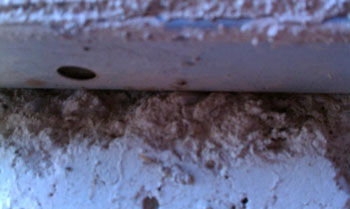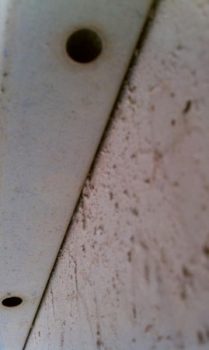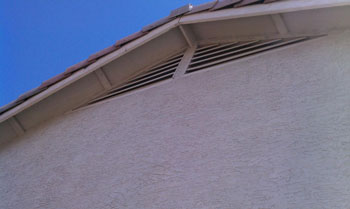Mechanical exclusion is by far the best and most effective action that can be taken to control
all pests because your home has many openings that pest can sneak into your through. Harborage elimination can help reduce pest hiding and breeding areas in your environment and can be done to and in addition to mechanical exclusion. Mechanical exclusion and harborage elimination can be addressed in areas of concern.


The first and most important area is around the area where most homes foundations meet the wall. There is a metal trim called a j-trim that is installed at the bottom of conventional frame contracted walls. The j-trim makes a flush contact from the stucco finish back to the foundation. If you were to lie down on your back or get a mirror and look at where the j-trim contacts the foundation you would see small gaps that range in size from nothing to inches. It is this gap that allows most insects to gain entry into the wall voids. Once in the wall voids the insects can fallow the wires, pipes, or conduit and travel through the walls into your home. Just like a roadway system directs the flow of traffic around a city the stated routes will direct the flow of insects into your home. The j-trim has to be sealed to keep insects from entering into the walls.


There are also holes that exist in the j-trim that are small circles or slits called weep holes that allow the walls to breath. In Arizona when considering sealing the j-trim the weep holes can be partially sealed or alternately sealed. With the high temperate we experience in the phoenix metropolitan area, the main concern is the expansion of hot air and allowing the expanding hot air to escape the wall void. By practically sealing the weep holes the wall voids can still breathe and insects can be prevented from entering. Doors are an area that all insects can enter a structure through. The weather stripping around any door will weaken with time. The door frame can be misaligned just enough to allow an opening that an opportunistic insect can take advantage of to gain entry. The gaps can have small amounts of customized sealing material installed to close them up. Old weather stripping on the bottom of doors
should be replaced. Depending on use opening and closing of the doors weather stripping may need to the replaced in 5-10 years. Sliding glass doors also have weather stripping under the door. This is usually a felt or brush type material. The door may need to be removed to allow inspection or repair. Garage doors can have a weather stripping installed that is glued to the concrete floor to form an effective sealed point of entry.
Windows may have small gaps or deep holes that allow insects to gain access to your home.
The window may also have a rail that it slides along to open that an insect can fallow and will lead to the interior of your home. The window weep holes can be practically sealed in some circumstances allowing water to still drain out but preventing insects from getting in. Cracks may exist around the window where the frame contacts the house and then should be sealed shut. These cracks may not be easily visible and an inspection may require mirrors, ladders, or the use of both.
All areas where wiring or other ridged conduit penetrates the wall should be sealed. The
entire circumference of conduit must be addressed. Any electrical box, phone box, cable box, or other utility boxes should be sealed around the entire perimeter where it contacts the wall of the structure.
The utility boxes generally have wires going into the wall of the home behind them, if the perimeter edge of the utility box is sealed the insect cannot gain entry or harbor behind them. Switch plates, electrical plates, or light fixtures may also have small cracks or crevices around that require sealing.


Around the roof line under the overhand where the wall makes contact with roof there are commonly a lot of cracks and crevices that need to be sealed. The structural components that comprise the soffit are where the underside of the roof overhang contacts the wall.
The soffits will have roof joint, attic vents, rafters and trim that will have many potential areas that require sealing the entire roof line should be addressed. All holes, cracks, crevices, or openings sealed shut. If the attic vents screens are too coarse or loose a finer mesh screen can be installed and secured tightly. The areas around the soffit s are as important to seal as the base of the house. Insects easily crawl up and if the soffit has entry ways the bugs are sure to find them.
Going inside the attic to seal around vent pipes that penetrate the roof can also help keep
pests out. The vent pipes penetrate the roof. The insects can crawl on to the top of the roof. The insects can crawl in between the roofing material then under the steel flashing and then down into your attic. A screen can be installed around the vent pipe and sealed to the underside of the roof if the insects take this route they become trapped in the screen and access is denied.
Expansion joints in your garage or porches may provide harborage for all insects. The expansion joint material is commonly felt type material that has cracks, crevices, and holes present. The cracks, crevices, and holes allow insects to enter crawl under the material and have a secluded, dark, protected bug cave to harbor in. hundreds of bugs have been see pouring out of these areas when there flooded by water or treated. These cracks can be sealed to prevent the insect utilizing them to live, bread, and congregate in it.
The most effective way to seal cinder block fence is to have it fully stuccoed. The
block fence is a huge harborage area for all insects. It will commonly have cracks crevices and voids that are conducive to insect harborage. Stuccoing the block fence is the sure way to eliminate the harborage it offers various bugs.
